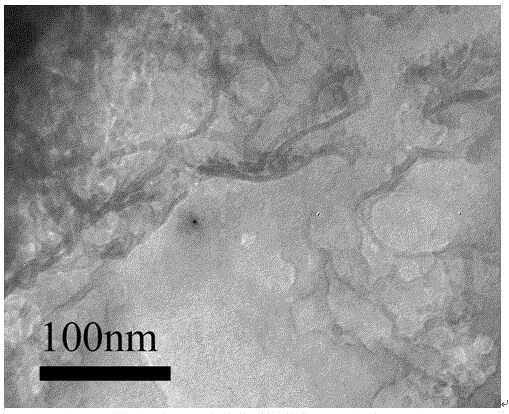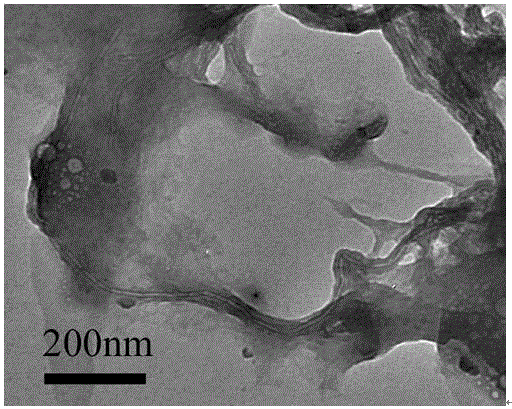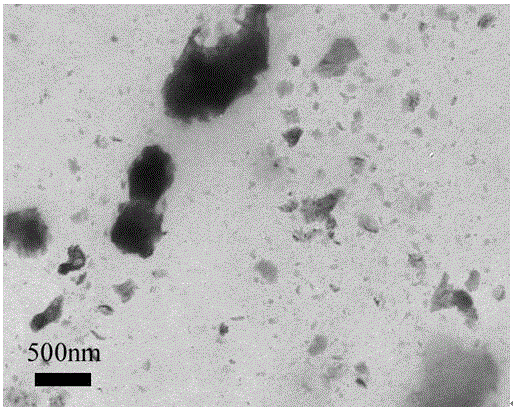Preparation method for improving performance of composite thermoelectric materials
A thermoelectric material, enhanced composite technology, applied in the manufacture/processing of thermoelectric devices, junction lead-out materials of thermoelectric devices, nanotechnology for materials and surface science, etc. problems, to achieve the effect of improving thermoelectric performance, simple preparation method and mild reaction conditions
- Summary
- Abstract
- Description
- Claims
- Application Information
AI Technical Summary
Problems solved by technology
Method used
Image
Examples
Embodiment 1
[0032] (1) Ingredients: First, add 1g polystyrene sodium sulfonate (PSSNa) into 145mL deionized water, stir and dissolve, then add 0.005g multi-walled carbon nanotube (MWCNT) and 0.005g graphene, and ultrasonically disperse evenly Afterwards, 1.25g of 3,4-ethylenedioxythiophene (EDOT) monomer was added dropwise, mechanically stirred until uniformly mixed, and N 2 1h.
[0033] (2) Polymerization: Add 0.05g of ferric sulfate and 2g of ammonium persulfate into 12.5g of deionized water, stir evenly, and then add to the dispersion obtained in step (1). The reaction process is N 2 Atmosphere, the mechanical stirring speed is 600rpm, the reaction temperature is 5°C, and the reaction time is 48h.
[0034] (3) Centrifugation and washing: After the polymerization is completed, the product is centrifuged, and the obtained black precipitate is washed and centrifuged repeatedly.
[0035] (4) Drying: The finally obtained black precipitate was vacuum-dried at 100° C. for 12 hours.
[003...
Embodiment 2
[0038] (1) Ingredients: first add 1g polystyrene sulfonate sodium (PSSNa) into 145mL deionized water, stir to dissolve, add 0.01g multi-walled carbon nanotubes (MWCNT), after ultrasonic dispersion is uniform, drop 1.25g 3, 4-Ethylenedioxythiophene (EDOT) monomer, mechanically stirred until uniformly mixed, and passed into N 2 1h.
[0039] (2) Polymerization: Add 0.05g of ferric sulfate and 2g of ammonium persulfate into 12.5g of deionized water, stir evenly, and then add to the dispersion obtained in step (1). The reaction process is N 2 Atmosphere, the mechanical stirring speed is 600rpm, the reaction temperature is 5°C, and the reaction time is 48h.
[0040] (3) Centrifugation and washing: after the polymerization is completed, the product is centrifuged, and the obtained black precipitate is repeatedly washed and centrifuged.
[0041] (4) Drying: The finally obtained black precipitate was vacuum-dried at 100° C. for 12 hours.
[0042] The conductivity of the sample obtain...
Embodiment 3
[0044] (1) Ingredients: First, add 1g of polystyrene sodium sulfonate (PSSNa) into 145mL of deionized water, stir and dissolve, then add 0.01g of graphene, after ultrasonic dispersion, add dropwise 1.25g of 3,4-ethylenedioxythiophene (EDOT) monomer, stir mechanically until evenly mixed, and pass into N 2 1h.
[0045] (2) Polymerization: Add 0.05g of ferric sulfate and 2g of ammonium persulfate into 12.5g of deionized water, stir evenly, and then add to the dispersion obtained in step (1). The reaction process is N 2 Atmosphere, the mechanical stirring speed is 600rpm, the reaction temperature is 5°C, and the reaction time is 48h.
[0046] (3) Centrifugation and washing: after the polymerization is completed, the product is centrifuged, and the obtained black precipitate is repeatedly washed and centrifuged.
[0047] (4) Drying: The finally obtained black precipitate was vacuum-dried at 100° C. for 12 hours.
[0048] The conductivity of the sample obtained in this example i...
PUM
| Property | Measurement | Unit |
|---|---|---|
| Outer diameter | aaaaa | aaaaa |
| Conductivity | aaaaa | aaaaa |
| Seebeck coefficient | aaaaa | aaaaa |
Abstract
Description
Claims
Application Information
 Login to View More
Login to View More - R&D
- Intellectual Property
- Life Sciences
- Materials
- Tech Scout
- Unparalleled Data Quality
- Higher Quality Content
- 60% Fewer Hallucinations
Browse by: Latest US Patents, China's latest patents, Technical Efficacy Thesaurus, Application Domain, Technology Topic, Popular Technical Reports.
© 2025 PatSnap. All rights reserved.Legal|Privacy policy|Modern Slavery Act Transparency Statement|Sitemap|About US| Contact US: help@patsnap.com



